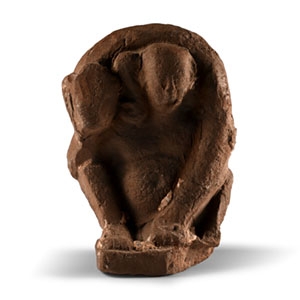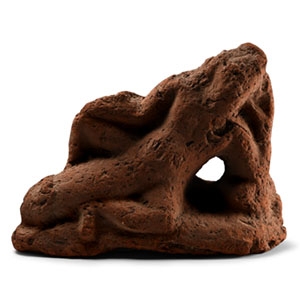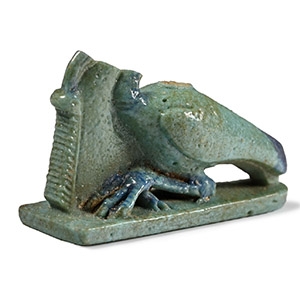Home > Auctions > 4 - 9 March 2025
Ancient Art, Antiquities, Books, Natural History & Coins
London art market, 2009.
This lot is accompanied by an illustrated lot declaration signed by the Head of the Antiquities Department, Dr Raffaele D’Amato.
The Erotica Collection Christian von Faber-Castell, Küsnacgt ZH, Switzerland, since the late 1970s.
This lot is accompanied by an illustrated lot declaration signed by the Head of the Antiquities Department, Dr Raffaele D’Amato.
Cf. Ross, T., ‘Egyptian Late Period figures in terracotta and limestone’ in Villing, A., Beregeron, M., Bourogiannis, G., Johnston, A., Leclere, F., Masson. A., Ross, T., Naukratis, Greeks in Egypt, London, 2015, pp.1-79, figs.93, 95, for a similar image of Harpocrates.
Ithyphallic figures in limestone, terracotta, gypsum and faience are relatively common in the 6th to 3rd-century B.C. deposits of Lower Egypt. Despite considerable variations, the group consistently depicts a seated ithyphallic plump baby with shaved head (or skull cap) and side-lock. They were identified by Gutch as Khonsu-Horus figures and subsequently by Bailey as Harpocrates, the Greek name for young Horus. Christian von Faber-Castell (born 1950) is a renowned German entrepreneur and art collector, best known as a member of the prominent Faber-Castell family, famed for their iconic writing instruments. A passionate advocate for art and culture, Christian von Faber-Castell curated an extensive and diverse private collection of erotica, spanning centuries and cultures. His collection reflects a deep appreciation for the interplay of beauty, sensuality, and artistic expression, bringing together rare and unique works that explore themes of intimacy and human connection. Pieces from this collection have been featured in notable exhibitions and are celebrated for their artistic and historical significance. This offering represents a rare opportunity to acquire works from one of the most fascinating and eclectic private collections of its kind.
From the collection of Walter Thomas Gaze Cooper (1895-1980); thence by descent.
This lot is accompanied by an illustrated lot declaration signed by the Head of the Antiquities Department, Dr Raffaele D’Amato.
Cf. Petrie, W.M.F., Scarabs and Cylinders with Names, London, 1917, pl. XXVIII, no. 70, for a scarab of Thutmose III with a similar design.
The popularity of this great Egyptian pharaoh was such that his name appeared on scarabs during his reign and into the Late Period.
Acquired before 1979.
From the private collection of Mr F.A., South Kensington, London, UK; thence by descent 2014.
This lot is accompanied by an illustrated lot declaration signed by the Head of the Antiquities Department, Dr Raffaele D’Amato.
Cf. similar specimens in faience at the Worcester Art Museum, inventory no.1925.539.
For thousands of years, artisans in Egypt created vibrant ceramics to echo the beauty of rare jewels. These ornaments were created with almost every material, colour, and texture imaginable and they come from across Egypt and beyond: vibrant blue lapis lazuli from Afghanistan, glossy black obsidian from Turkey, and aqua-green turquoise from the Sinai. They were worn in life and, after death, they served as precious ornamentation for mummies.
The Erotica Collection Christian von Faber-Castell, Küsnacgt ZH, Switzerland, since the late 1970s.
This lot is accompanied by an illustrated lot declaration signed by the Head of the Antiquities Department, Dr Raffaele D’Amato.
Cf. Nagwa Abdelnaby, A.I., ‘Two unpublished Figurines of Women Purifying themselves in the Greco-Roman Museum of Alexandria’ in Bulletin of the Center Payrological, 38 (1), November 2021, pp.645-664, figs.3, lett. A and D.
Baubo was a minor divinity of the Greek mythology, linked to the cult of Demeter and Persephone. The statuette belongs to the second type of Baubo figurines, widespread in the last Ptolemaic and Roman period in Egypt. The Egyptian Baubo are split into two groups, and this one belongs to the first group depicting a woman seating frontally whilst holding a musical instrument. In some of these figurines her right hand is touching her genitalia. Many of them were used as amulets or as ex-voto. Christian von Faber-Castell (born 1950) is a renowned German entrepreneur and art collector, best known as a member of the prominent Faber-Castell family, famed for their iconic writing instruments. A passionate advocate for art and culture, Christian von Faber-Castell curated an extensive and diverse private collection of erotica, spanning centuries and cultures. His collection reflects a deep appreciation for the interplay of beauty, sensuality, and artistic expression, bringing together rare and unique works that explore themes of intimacy and human connection. Pieces from this collection have been featured in notable exhibitions and are celebrated for their artistic and historical significance. This offering represents a rare opportunity to acquire works from one of the most fascinating and eclectic private collections of its kind.
Ex UK gallery, early 2000s.
This lot is accompanied by an illustrated lot declaration signed by the Head of the Antiquities Department, Dr Raffaele D’Amato.
Cf. Hermann, C., Ägyptische Amulette aus Palästina/Israel: Band III, Fribourg/Göttingen, 2006, pl.CI, no.460, for a similar example.
Amulets in the form of poppies were used to heal and alleviate pain and to ward off death. These types of amulets were also linked to Osiris, the Egyptian deity of agriculture, death, and the afterlife.
From an old English deceased estate.
Acquired on the Yorkshire art market in the early 1990s.
Property of a London, UK, collector.
This lot is accompanied by an illustrated lot declaration signed by the Head of the Antiquities Department, Dr Raffaele D’Amato.
From an early 20th century collection.
This lot is accompanied by an illustrated lot declaration signed by the Head of the Antiquities Department, Dr Raffaele D’Amato.
Cf. Andrews, C., Amulets of Ancient Egypt, London, 1994, item 29(c).
The Erotica Collection Christian von Faber-Castell, Küsnacgt ZH, Switzerland, since the late 1970s.
This lot is accompanied by an illustrated lot declaration signed by the Head of the Antiquities Department, Dr Raffaele D’Amato.
Cf. Ross, T., ‘Egyptian Late Period figures in terracotta and limestone’ in Villing, A., Beregeron, M., Bourogiannis, G., Johnston, A., Leclere, F., Masson. A., Ross, T., Naukratis, Greeks in Egypt, London, 2015, pp.1-79, fig.109, for a similar reclining Harpocrates.
A few early Hellenistic terracotta figures show the ithyphallic youth Harpocrates reclining on his phallus, usually depicted (when preserved) with a bald or shaved head and side-lock, sometimes in Macedonian dress. Some in this form have hermaphrodite-like features, although this may be little more than just the representation of a plump baby. Christian von Faber-Castell (born 1950) is a renowned German entrepreneur and art collector, best known as a member of the prominent Faber-Castell family, famed for their iconic writing instruments. A passionate advocate for art and culture, Christian von Faber-Castell curated an extensive and diverse private collection of erotica, spanning centuries and cultures. His collection reflects a deep appreciation for the interplay of beauty, sensuality, and artistic expression, bringing together rare and unique works that explore themes of intimacy and human connection. Pieces from this collection have been featured in notable exhibitions and are celebrated for their artistic and historical significance. This offering represents a rare opportunity to acquire works from one of the most fascinating and eclectic private collections of its kind.
From an early 20th century collection.
This lot is accompanied by an illustrated lot declaration signed by the Head of the Antiquities Department, Dr Raffaele D’Amato.
Cf. several comparable faience openwork amulets were discovered in the tomb of Amenhotep III (e.g. Metropolitan Museum of Art 26.7.1083), these are discussed in Hayes, W.C., The Scepter of Egypt. A Background for the Study of the Egyptian Antiquities in The Metropolitan Museum of Art, Vol. 2, New York, 1990 (reprint), p.243.
with Bonhams, Knightsbridge, 3 October 2000, no.413.
Private collection, Europe.
This lot is accompanied by an illustrated lot declaration signed by the Head of the Antiquities Department, Dr Raffaele D’Amato.
Cf. Andrews, C., Amulets of Ancient Egypt, London, 1994, p.25, no.21f, for a similar example.
The ibis was considered sacred to the god Thoth. It is likely that the popularity of amulets depicting an ibis resting its beak on the feather of Maat in the funerary sphere is connected to Thoth's role as the recorder of the final judgment of the deceased by the divine tribunal. This tribunal determined if the deceased had lived a virtuous life and could enter the Underworld. This was visually represented by the deceased's heart placed on scales with the feather of Maat; if the heart and feather balanced, eternity was assured.
PTOLEMAIC PERIOD, 3RD-2ND CENTURY B.C.
The Erotica Collection Christian von Faber-Castell, Küsnacgt ZH, Switzerland, since the late 1970s.
This lot is accompanied by an illustrated lot declaration signed by the Head of the Antiquities Department, Dr Raffaele D’Amato.
Cf. Ross, T., ‘Egyptian Late Period figures in terracotta and limestone’ in Villing, A., Beregeron, M., Bourogiannis, G., Johnston, A., Leclere, F., Masson, A., Ross, T., Naukratis, Greeks in Egypt, London, 2015, pp.1-79, fig.105, for a similar ithyphallic Harpocrates.
From the 4th century B.C. onwards, small-scale sculptures developed a rich repertoire of grotesque types. These so-called grotesques were an enhancement of the Hellenistic interest in the human body and its weaknesses and imperfections by depicting disfigured individuals. According to some scholars, terracotta (and bronze) figurines of this kind were life-like representations of beggars and others who gathered at big feasts in temples or at the houses of the wealthy. In the latter case, they indicated the importance and wealth of the host because the more beggars an event attracted, the greater the fortune of the event organiser. By implication, the bronze and terracotta portraits of these marginal people could have become symbols and charms of good luck that would have been placed in private houses. This image in particular, has evolved from the ithyphallic Harpocrates terracottas. Christian von Faber-Castell (born 1950) is a renowned German entrepreneur and art collector, best known as a member of the prominent Faber-Castell family, famed for their iconic writing instruments. A passionate advocate for art and culture, Christian von Faber-Castell curated an extensive and diverse private collection of erotica, spanning centuries and cultures. His collection reflects a deep appreciation for the interplay of beauty, sensuality, and artistic expression, bringing together rare and unique works that explore themes of intimacy and human connection. Pieces from this collection have been featured in notable exhibitions and are celebrated for their artistic and historical significance. This offering represents a rare opportunity to acquire works from one of the most fascinating and eclectic private collections of its kind.
265 - 276 of 3546 LOTS



.jpg)


.jpg)









